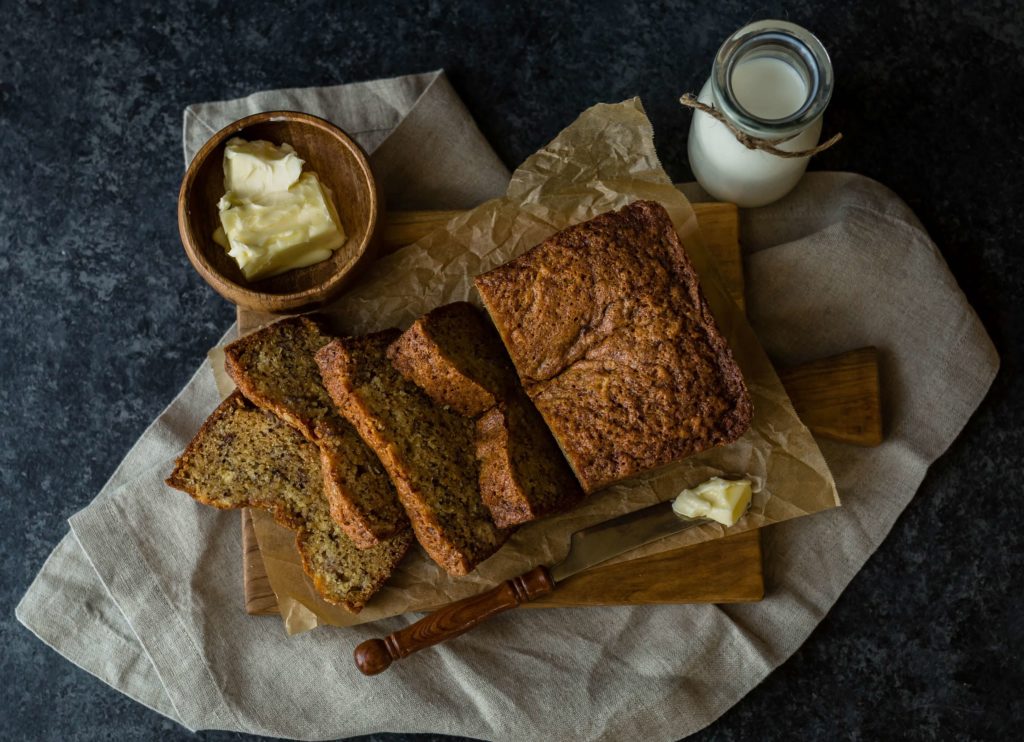
Are you craving a delicious homemade treat but don’t want to spend hours in the kitchen? Look no further! In this article, we’ll provide you with a printable step-by-step easy banana bread recipe that will satisfy your taste buds and save you time. Whether you’re a seasoned baker or a beginner in the kitchen, this recipe is perfect for anyone looking to whip up a scrumptious banana bread in no time. So grab your ingredients and get ready to enjoy a warm slice of heaven!
Banana bread is a classic favorite that never disappoints. With our easy-to-follow recipe, you’ll be able to create a moist and flavorful loaf of banana bread in just a few simple steps. We understand that not everyone has hours to spend in the kitchen, which is why we’ve designed this recipe to be quick and hassle-free. From mashing the ripe bananas to mixing in the perfect amount of cinnamon and vanilla, we’ll guide you through each step to ensure your banana bread turns out perfectly every time.
Ingredients for Easy Banana Bread

If you’re a fan of delicious and moist banana bread, then you’re in for a treat! Making your own homemade banana bread is easier than you think, and the best part is that you can print out a step-by-step recipe to guide you through the process. Before we dive into the instructions, let’s take a look at the key ingredients you’ll need to make this easy banana bread:
- Ripe bananas: The star of the show! Make sure to use bananas that are nice and ripe, with plenty of brown spots on the skin. These bananas will not only lend a wonderful sweetness to the bread but also provide moisture and flavor.
- All-purpose flour: This is the base of the bread and gives it structure. Make sure you measure it accurately for the perfect texture.
- Granulated sugar: Adds sweetness to balance out the natural tartness of the bananas.
- Unsalted butter: Adds richness and moisture to the bread. Make sure it’s softened before you start.
- Eggs: They bind the ingredients together and add moisture to the bread. Make sure they’re at room temperature for best results.
- Baking soda: This leavening agent helps the bread rise and gives it a light and fluffy texture.
- Salt: Just a pinch will enhance the flavors and balance the sweetness.
- Cinnamon: Adds a warm and comforting aroma to the bread.
- Vanilla extract: Enhances the overall flavor profile of the banana bread.
Step 1: Preparing the Oven
Now that you have all the ingredients ready, it’s time to start baking your delicious banana bread! The first step is to prepare your oven.
1. Preheat the oven: Before you begin mixing the ingredients, preheat your oven to 350°F (175°C). This will ensure that the oven is at the right temperature when it’s time to bake the banana bread.
2. Grease the loaf pan: Take a loaf pan and lightly grease it with butter or cooking spray. This will help prevent the banana bread from sticking to the pan and make it easier to remove once it’s baked.
3. Line the pan with parchment paper (optional): If you want to make it even easier to remove the banana bread from the pan, you can also line it with parchment paper. Simply cut a piece of parchment paper to fit the bottom of the pan and place it inside.
4. Adjust the oven rack: Make sure the oven rack is placed in the center position. This will help ensure that the bread bakes evenly from all sides.
5. Check the oven temperature: Once the oven has preheated, double-check the temperature using an oven thermometer. This will ensure that the oven is at the correct temperature for baking the banana bread.
By following these simple steps, you’ll have your oven prepped and ready to bake the perfect loaf of banana bread. Now, it’s time to move on to the next step – preparing the bananas.
Step 2: Mashing the Bananas
Now that you’ve prepared the oven and greased the loaf pan, it’s time to move on to the next step: mashing the bananas. This is a crucial part of the banana bread-making process, as it helps to create a moist and flavorful loaf.
To begin, make sure you have ripe bananas on hand. The riper the bananas, the sweeter and more flavorful your bread will be. Look for bananas that have a few brown spots on the peel – these are the perfect ones for mashing.

Once you have your ripe bananas, it’s time to get mashing. Here’s how you do it:
- Start by peeling the bananas and placing them in a mixing bowl.
- Grab a fork or a potato masher and begin mashing the bananas until they have a smooth and creamy consistency.
- If you prefer a chunkier texture, you can leave some small banana chunks in the mixture.
Mashing the bananas not only helps to incorporate them evenly into the bread batter, but it also releases their natural sweetness and flavor. As you mash the bananas, you’ll notice their aroma filling the air, making your kitchen smell absolutely delightful.
Once you’ve mashed the bananas to your desired consistency, you’re ready to move on to the next step: adding the dry ingredients. But we’ll save that for the next section.
Remember, mashing the bananas is an important step in creating a delicious banana bread. So take your time, enjoy the process, and revel in the anticipation of the mouthwatering aroma that will soon fill your home.
Stay tuned for Step 3: Adding the Dry Ingredients.
Step 3: Mixing the Wet Ingredients
Now that you have mashed the ripe bananas to perfection, it’s time to move on to the next step: mixing the wet ingredients. This is where the magic happens, as the wet ingredients help create a moist and flavorful banana bread. So, grab a mixing bowl and let’s get started!

« Delicious Banana and Egg Pancake Recipe: Simple Steps, Nutritional Benefits, and Perfecting Tips
Easy and Healthy Banana Pancake Recipe for Babies: Step-by-Step Guide »
1. Gather your ingredients
Before you begin, make sure you have all the necessary ingredients for this step. You will need:
- 2 large eggs
- 1/2 cup of melted butter (unsalted)
- 1/2 cup of granulated sugar
- 1 teaspoon of vanilla extract
2. Beat the eggs
In a separate bowl, crack the eggs and beat them until they are well combined. Beating the eggs will help incorporate air into the mixture, resulting in a lighter and fluffier banana bread.
3. Add the melted butter
Next, add the melted butter to the beaten eggs. The melted butter adds richness and moisture to the banana bread. Make sure the butter is cooled slightly before adding it to the mixture to avoid scrambling the eggs.
4. Mix in the sugar and vanilla extract
It’s time to add the granulated sugar and vanilla extract to the bowl. The sugar adds sweetness to the bread, while the vanilla extract enhances the banana flavor. Mix everything together until the sugar is fully dissolved.
5. Incorporate the mashed bananas

Lastly, add the mashed bananas to the mixture and gently fold them in. Mixing the mashed bananas evenly into the wet ingredients ensures that every bite of your banana bread is bursting with flavor.
Step 4: Combining Dry Ingredients
Now that you have prepared the wet ingredients, it’s time to move on to the next step: combining the dry ingredients. This is an important part of the banana bread-making process, as it helps to create the perfect texture and flavor in your loaf.
To start, you’ll need a large mixing bowl. Measure out 2 cups of all-purpose flour and add it to the bowl. Flour is the main dry ingredient in this recipe and provides structure to the banana bread.
Next, add 1 teaspoon of baking soda and 1/2 teaspoon of salt to the bowl. Baking soda helps the bread rise, while salt enhances the overall flavor. These two ingredients work together to create a well-balanced and delicious loaf.
It’s time to incorporate the dry ingredients into the wet mixture. Slowly add the dry mixture to the wet mixture, stirring gently with a wooden spoon or spatula. Be careful not to overmix, as this can result in a dense and tough bread. Mix just until the dry ingredients are fully incorporated, and you no longer see any streaks of flour.

At this point, you can get creative and add any additional ingredients that you like. Some popular choices include chopped nuts, such as walnuts or pecans, or chocolate chips for a touch of sweetness. These additions will add extra texture and flavor to your banana bread.
Remember, the key to a successful banana bread is to not overmix the batter. Just a few gentle stirs are all that’s needed to combine the dry ingredients. Overmixing can lead to a dense and tough bread, so be mindful of this as you mix.
With the dry ingredients combined, you’re one step closer to enjoying a delicious homemade banana bread. The next step will bring the wet and dry ingredients together to create the final batter. Let’s move on to Step 5: Mixing the Batter.
Step 5: Combining Wet and Dry Ingredients
Once you have prepared the wet and dry ingredients for your banana bread, it’s time to bring them together. This step is crucial in creating a moist and flavorful loaf that will have your taste buds dancing with delight.
To begin, pour the wet ingredients, which include eggs, melted butter, sugar, and vanilla extract, into a large mixing bowl. These ingredients will not only add richness and sweetness to your banana bread but also help bind everything together.

Next, you’ll need to slowly add the dry ingredients to the wet mixture. The dry ingredients consist of all-purpose flour, baking soda, and salt. This combination of ingredients helps to give your banana bread the perfect texture and flavor.
When combining the wet and dry ingredients, it’s important not to overmix. Overmixing can result in a dense and tough bread. Instead, gently fold the dry ingredients into the wet mixture until just combined. This will ensure a tender and moist banana bread.
If you want to take your banana bread to the next level, now is the perfect time to add any optional additions. Chopped nuts, such as walnuts or pecans, can provide a satisfying crunch. Alternatively, you can sprinkle in some chocolate chips for a delightful burst of sweetness.
Once all the ingredients are combined and any optional additions are mixed in, your banana bread batter is ready to be poured into a greased loaf pan. Make sure to scrape down the sides of the bowl to get every last bit of the delicious batter.
Step 6: Pouring the Batter into the Pan
Now that you have prepared the delicious banana bread batter, it’s time to pour it into the loaf pan. This step is crucial as it will determine the shape and texture of your banana bread. Here’s how to do it:
- Prepare the loaf pan: Before pouring the batter, make sure to grease the loaf pan with butter or cooking spray. This will prevent the bread from sticking to the pan and make it easier to remove once it’s baked.
- Pour the batter: Slowly pour the batter into the prepared loaf pan, making sure to distribute it evenly. Use a spatula or a spoon to scrape the sides of the bowl, ensuring that you get every last bit of deliciousness into the pan.
- Smooth the top: Once all the batter is in the pan, use the back of a spoon or spatula to gently smooth the top. This will help create an even surface and ensure that the bread bakes evenly.
- Optional toppings: If you’d like to add a little extra flair to your banana bread, now is the time to sprinkle on some optional toppings. You can add a handful of chocolate chips, chopped nuts, or even a sprinkle of cinnamon sugar for added flavor and texture.
- Bake it to perfection: Place the filled loaf pan in the preheated oven and bake according to the recipe instructions. Keep an eye on it as it bakes, and when the top turns golden brown and a toothpick inserted into the center comes out clean, your banana bread is ready!

Remember, pouring the batter into the pan is the final step before your banana bread goes into the oven. Take your time and enjoy the process. As the sweet aroma fills your kitchen, you can already imagine the delightful treat that awaits you. So go ahead, pour that batter with love, and get ready to indulge in a slice of homemade banana bread goodness.
Step 7: Baking the Banana Bread
Now that you have prepared the banana bread batter, it’s time to bake it to perfection. The aroma of freshly baked banana bread will soon fill your kitchen, making it hard to resist indulging in a warm slice. Get ready to enjoy the fruits of your labor!
- Preheat your oven to 350°F (175°C). It’s important to preheat the oven so that the banana bread bakes evenly and rises properly.
- Grease a loaf pan with butter or cooking spray. This will prevent the banana bread from sticking to the pan and make it easier to remove once it’s baked.
- Pour the prepared batter into the greased loaf pan. Use a spatula to scrape every last bit of the delicious batter into the pan. Spread it evenly to ensure that the banana bread bakes uniformly.
- If desired, you can add some optional toppings to enhance the flavor and presentation of your banana bread. Sprinkle some chopped nuts or chocolate chips on top of the batter. This will add a delightful crunch or a burst of indulgent sweetness to each bite.
- Place the loaf pan in the preheated oven and bake for 50-60 minutes. Keep an eye on the banana bread as it bakes. You’ll know it’s done when the top turns golden brown and a toothpick inserted into the center comes out clean or with a few moist crumbs clinging to it.
- Once baked, carefully remove the pan from the oven using oven mitts. Allow the banana bread to cool in the pan for about 10-15 minutes. This will make it easier to remove the bread from the pan without it falling apart.
- After the cooling period, transfer the banana bread to a wire rack to cool completely. This will prevent moisture from accumulating on the bottom and ensure a moist and tender texture throughout.
- Once the banana bread has cooled completely, it’s time to savor the deliciousness. Slice the bread into thick or thin slices, depending on your preference. You can enjoy it as is, spread some butter or cream cheese on top, or even make it into a delightful French toast.
Step 8: Testing for Doneness
After patiently waiting for your banana bread to bake, it’s time to check if it’s done. Testing for doneness is an important step to ensure that your loaf is perfectly baked and moist on the inside. Here’s what you need to do:
- The Toothpick Test: Take a toothpick or a wooden skewer and insert it into the center of the bread. If it comes out clean or with just a few moist crumbs clinging to it, your banana bread is ready. If there is still wet batter on the toothpick, it needs more time in the oven.
- The Finger Press Test: Gently press the top of the loaf with your finger. If it springs back and feels firm, it’s a good sign that your banana bread is done. However, if it leaves an indentation or feels too soft, it needs a little more time to bake.
- The Visual Check: Another way to determine if your banana bread is done is by looking at its appearance. The top should be golden brown and slightly cracked. If it looks undercooked or pale, it needs more time in the oven.
Remember, baking times can vary depending on your oven, the size of your loaf pan, and the moisture content of your bananas. It’s always best to rely on these tests rather than sticking to an exact baking time.
If your banana bread needs more time, simply return it to the oven and continue baking for a few more minutes. Keep an eye on it to prevent over-baking, which can result in a dry loaf.

Once your banana bread passes the doneness test, remove it from the oven and place it on a wire rack to cool for about 10-15 minutes. This allows the loaf to firm up and makes it easier to remove from the pan without falling apart.
Congratulations! You’re almost ready to enjoy your homemade banana bread. But before diving in, it’s important to let it cool completely on the wire rack. This additional cooling time allows the flavors to develop and the loaf to set, resulting in a moist and delicious treat.
So, be patient and resist the temptation to slice into your banana bread too soon. Trust me, the wait will be worth it!
Now that you know how to test for doneness, you’re one step closer to becoming a banana bread master. Soon, you’ll be able to whip up this delightful treat anytime you have overripe bananas on
Step 9: Allowing the Banana Bread to Cool
Now that your delicious banana bread is baked to perfection, it’s time to let it cool down. This step is crucial because it allows the bread to set and become moist and tender on the inside. You don’t want to rush this process, as it can affect the texture and taste of your banana bread. So, grab a cup of coffee or tea, and enjoy a few moments of anticipation as you wait for your bread to cool.

After removing the banana bread from the oven, leave it in the loaf pan for about 10-15 minutes. This allows the bread to set and become more stable. It also makes it easier to remove the bread from the pan without it falling apart. During this time, the residual heat in the pan continues to cook the bread slightly, ensuring that it’s evenly baked throughout.
Once the initial cooling time has passed, carefully transfer the banana bread from the loaf pan to a wire rack. This step is important because it allows air to circulate around the bread, preventing it from becoming soggy on the bottom. It also helps the bread cool down faster. Allow the banana bread to cool completely on the wire rack before slicing and serving.
While it may be tempting to dive right into the warm and fragrant banana bread, resist the urge. Cooling the bread allows the flavors to develop and intensify, resulting in a more delicious and satisfying eating experience. It also gives the bread time to firm up, making it easier to slice without crumbling.
Remember, good things come to those who wait. So, take your time and savor the anticipation as your banana bread cools down to the perfect temperature. Once it’s completely cooled, you can finally indulge in a slice of moist, flavorful, and homemade banana bread.
Step 10: Slicing and Serving the Banana Bread
Now that your banana bread is cooled and ready to be enjoyed, it’s time to slice it and savor the deliciousness! Follow these simple steps to ensure perfect slices every time:
- Prepare your cutting board and knife: Place a clean cutting board on your countertop and grab a sharp knife. A serrated knife works best for slicing banana bread, as it will help you achieve clean and even slices.
- Remove the banana bread from the pan: Carefully invert the loaf pan over the cutting board and gently tap the bottom to release the banana bread. If it doesn’t come out easily, you can use a butter knife to loosen the edges.
- Decide on the thickness: Consider how thick you want your slices to be. A 1/2-inch thickness is a good starting point, but feel free to adjust according to your preference.
- Start slicing: Using a gentle sawing motion, cut through the banana bread, moving the knife back and forth. Remember to keep your fingers away from the blade for safety.
- Repeat: Continue slicing until you have cut through the entire loaf. If you notice the knife sticking to the bread, wipe it clean with a damp cloth or rinse it under warm water before continuing.
- Serve and enjoy: Once you have sliced the banana bread, you can serve it on a platter or individual plates. It’s best enjoyed fresh, but you can also store it in an airtight container for a few days.

Now that you know how to slice and serve your banana bread, it’s time to enjoy the fruits of your labor! Whether you prefer a plain slice or want to spread some butter or cream cheese on top, this delicious treat is sure to satisfy your taste buds. Share it with friends and family or indulge in a slice all by yourself. The choice is yours!
Conclusion
Now that you have all the steps and tips for making a delicious banana bread, it’s time to get baking! Remember to use ripe bananas for the best flavor and consistency. Follow the instructions for mashing the bananas and mixing the wet and dry ingredients separately. Don’t forget to add any optional additions like nuts or chocolate chips if desired. Once the batter is poured into the loaf pan, bake it in a preheated oven and use one of the three methods provided to check for doneness. After cooling, you can slice the banana bread to your desired thickness and enjoy it fresh or store it in an airtight container. With this easy recipe, you’ll be able to make a moist and flavorful banana bread that everyone will love. Happy baking!










